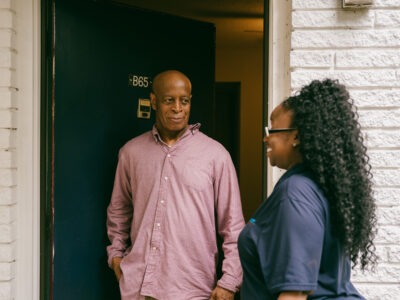Community Solutions President Rosanne Haggerty joined our partners Walker & Dunlop for a Q&A in their Multifamily Outlook quarterly report for Summer 2020. Together, they discussed the role of the property development community in ending homelessness.
Tell us about the early days of Community Solutions.
We started out as a housing developer, just in the New York area, as we believed that housing was the only solution to homelessness. After a few years, we noticed that while we were building lots of housing, homelessness was still rising all around us. We came to understand that housing supply alone couldn’t solve homelessness; rather we needed an entire, coordinated system to connect those experiencing homelessness to housing and to prevent vulnerable people from becoming homeless in the first place. We launched Community Solutions to work with innovative cities and counties to learn together how to create coordinated housing systems designed to eliminate homelessness, starting with chronic and veteran homelessness.
What does an “accountable” housing system mean to a multifamily developer, owner, operator, or investor?
You can’t build your way out of homelessness. Communities first need a 360 degree view of why people are becoming and getting stuck in homelessness. Our work involves helping communities to build local housing systems where all players work together and share accountability for making homelessness rare, and brief when it occurs. The key is organizing the key actors in each community around the same table, focused on the same goal, and sharing the same information. It’s the level of collaboration one sees in other sectors dealing with many moving parts where teams use specific, real time data to guide their efforts, learn what is working and relentlessly improve their efforts.
An estimated 40-45% increase in homelessness has been projected due to the economic crisis. What can be done to keep that number from rising even more?
COVID-19 has put so many households at risk due to the economic crisis, but we are looking at it as an opportunity as well as a threat.
We see efforts where landlords are really stepping up to be helpful to tenants. They’re worried about their tenants’ health first, then concerned about rent. Landlords, tenants, and communities all have very aligned interests. This is a moment to work together to find solutions.
Significant government intervention will be needed as well to head off this crisis. The whole property industry -the whole country- has a stake in seeing that the Senate includes the housing assistance proposed in the HEROES Act passed by Congress in the next stimulus bill.
Tell us about the similarities between Community Solutions and the property development community?
We feel real kinship with the property development and operating community as we know what’s involved and how challenging this work is. As in property development, we look at a whole community. Our community data and improvement coaches and real estate experts work as a team with our local partners, including addressing housing supply issues when a community’s data points to specific gaps. It’s an essential part of our strategy.
Addressing a problem holistically and creatively can expedite solutions. Take for example, Denver, Colorado, which is a hot rental market. Even though all remaining homeless veterans had rental subsidy vouchers, in a market with a vacancy rate of only 1 percent, landlords didn’t want to deal with the requirements of a federal program. So, Community Solutions used social impact capital to acquire existing rental housing and pledge vacancies to homeless veterans as units turned over. We reached out to high net worth individuals who would accept a smaller return for their investment. The building, with 66 units, is located just one mile from the VA hospital. And we closed in only 120 days.
What role do multifamily developers/owners/operators play in helping to end homelessness?
Their participation in local teams has been critical to achieving reductions in homelessness in the places we work with. Landlords who see themselves as part of a community housing system aimed at ending homelessness have been pivotal to the process.
If developers are interested in doing even more, we encourage them to look at our Built For Zero communities. Built For Zero is made up of more than 80 cities and counties that have committed to measurably ending homelessness, one population at a time. These communities are using data to change how local homeless response systems work and the impact they can achieve.
Multifamily developers and operators can provide their communities with information on housing, available support, and act as an early warning system for struggling people facing housing emergencies. There’s an enormous role for the property sector to play, as these are the true experts on the demographics of their markets, and know who is not being served by existing processes, and the typologies of housing that are in too short supply. This information is so valuable for innovators in real estate development and to inform local homelessness prevention strategies.
We also all need to ask ourselves: Why do we still build communities that tolerate homelessness?
We also all need to ask ourselves: Why do we still build communities that tolerate homelessness?
Rosanne HAggerty, CEO OF COMMUNITY SOLUTIONS
Which cities are models for combating homelessness?
In the United States, two big success stories are in Jacksonville, FL and Rockford, IL, cities with very different geographies and politics.
Jacksonville has completely crushed it. They’ve nearly ended veteran homelessness by putting every entity in the county that interacts with homeless veterans around the same table: shelters, the VA medical center, landlords and landlord representatives, the coordination team, and more.
Rockford is a post-industrial city with lots of economic struggles, but they’ve ended veteran and chronic homelessness, and they’re well on their way in reducing youth homelessness. Rockford made ending homelessness a real community mission and they’re enlisting the property sector to be responsive to the problem.
Internationally, we can look at Finland. There they made a national policy decision and provided financial incentives to turn nearly all shelters throughout the country into permanent housing. They dramatically reduced homelessness as a result.
What’s ahead for Community Solutions?
We are just launching our strategic plan for the next four years. We’re proud that already 13 communities have ended chronic homelessness and over 40 have seen steady reductions.
Our next step is to get to the point where we’ve helped a critical mass of diverse communities end homelessness, proving it possible and necessary everywhere. That means removing regulations and barriers and changing minds. As we’ve seen during the COVID-19 pandemic, if any of us are to remain safe, then all of us must have the ability to be safely housed.
As we look ahead, we are honored to continue our partnership with Walker & Dunlop, who have given us flexible financial support for several years. This is so essential to a group like ours as we cut a new path. What keeps many communities from taking the necessary next steps are rigidly designed programs and financing. We’re so appreciative of partners like Walker & Dunlop who give us the freedom, flexibility, and support to move forward.




